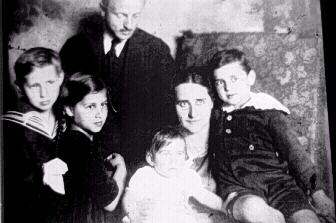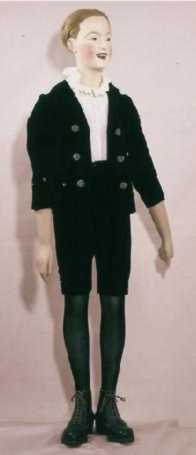
Figure 1.--This German Jewish family after the turn of the century dressed their older boy in a sailor suit and the younger boy in a one-piece Fauntleroy suit.


Figure 1.--This German Jewish family after the turn of the century dressed their older boy in a sailor suit and the younger boy in a one-piece Fauntleroy suit. |
Fauntleroy suits began to change in the after the turn of the
century. I'm not
sure about the precise timing of these changes, but hope this will
emerge as my research on the subject continues. I believe that this
change conforms to the Edwardian period. (The reign of Edward VII was
only 1901-10, but some fashions begun to change before Queen Victoria's
death in 1901.) Several changes occured to the classic Fauntleroy suit.
The small jackets to show off the lace trimed blouses vecame less common.
Some of the more important changes were to the pants. Kickers and
shorts appeared and were often worn with long white stockings or knee
and calf-length socks instead of long black stockings-leaving a boys' knees
or calves bare. Whether it was shorts or knickers, keepants became
less cpmmon. Fauntleroy dresses passed from the boys'
fashion scene. The high-top button boots were replaced with a more refined
look. A boy might wear patent leather strap shoes when attending a party
or for other formal wear. Some older boys still wore long hair, especially
in France. American and British boys, however, rarely wore the
long shoulder-length curls seen in the 1880s and early 1890s.
While not as dominate as in the 1880s-90s, the Fauntleroy suit
was still commonly worn by boys in the Edwardian era. Many boys
continued to wear them as their party suit. I have the impression that
during the Edwardian period that the Fauntleroy was muchnmore likely to be
worn by wealthier boys as oppposed to the earlier period when it was
a fashion widely worn by a wide cross section of society. The Fauntleroy suit for older boys in particular was a style only worn by wealthy or aristocratic boys. Most Fauntleroy suits were worn by boys only up to 7 or 8 years. This was largely set in England by the age at which a boy began his boarding school education. This convention gradually was adopted in America, even though boarding school education was less common. For the most part, boys older than this age wearing Fauntleroy suits were from wealthy or aristocratic families.

Figure 2.--This Fauntleroy suit was worn in England around the turn of the 20th Century. Note the ruffled collar that had begun to replace lace collars. |
Some of the major Edwardian stylistic changes were as follows.
It should be noted that the changing styles were not abruptly adopted.
Nor were they adopted wholesale at one time. Thus there were boys wearing
the classic style suits in the 1900s and were there were boys wearingb the
Edwatdian style suits in the 1890s. In addition, some boys wore suits
with mixed elements, some Victorian Fauntleroy elements and some
Edwardian elements.
The Fauntleroy dresses commonly worn in the 1880s and 90s became less
common in the 1900s, especially by the 1910s. Boys by the 1910s wore
much plainer dresses than in the late 19th Century and older boys were
no longer kept in dresses o any style.
The small jacket worn so as not to hide a fancy Fauntleroy blouse with
fancy lace collars and cuffs disppeared in the first decade of the 1900s.
Imstead a boy was more likely to wear a jacket fully covering his blouse and buttoned to the neck. This made a fancy blose unecessary. Jackets were often worn with the lace work sewn on to the jacket rather than part of a blouse.
Blouses were still worn, but not as commonly as with the Victorian
Fauntleroy suit. The lace trimed blouse of the Victorian era was
increasingly worn with elaborate ruffles rather than lace. In part this was a fashion shift, but another factor was the usage of the style by more cost conscious middle-class mothers. Real lace was quite exopensive.
The Victorian Fauntleroy suit was commonly worn with kneepants,
almost always with three buttons at the knee hem. These buttons were
ornamental, a carry over from 19th Century knee breeches. Boys in
after the turn of the century increasingly wore knicker pants pursed at
the hem. The knickers were usually worn below the knee, but some
suits had above the knee knickers. Some suits were made with
short pants. Intially the shorts were not much shorter than knee pants, but they were gradually worn at shorter length. We tend to note the bloomer/knicker pants more commonly in England and France than in the United states where the stright knee pants were more common. e hve not noted Fauntleroy suits made with long pants.
Victorian Fauuntleroy suits were worn with long black stockings. Even
little boys wore long stockings comlelketly covering his legs. The stockings
were black or other dark colors complementing the color of the suit. Some
boys continued wearing long stckings in the 1900s. This was especially
true for Fauntleroy suits worn for especially formal occasions. While
long dark stockings became less common, long white stockings were worn
and continued to be fashionable. After the turn of the century boys increasingly began wearing socks rather than long stockings. Boys began wearing socks of various lengths, from kneesocks, calf-length socks, and ankle socks. It thus began increasingly common to see boys in Fauntleroy suits with bare knees and
legs. Socks also varied in color. In the 1900s they were mostly dark
socks, but by the 1910s white short socks and kneesocks might be worn.
Heavy button high top shoes generally disappeared after the turn of the
century. Fancy Fauntleroy were ,ore likely to be worn with low cut shoes.
Boys for dress occasions might wear patent leather single strap shoes.
I'm not sure yet how cap and hat styles changed in the Edwardian era.
The long ringlet curls worn by boys at shoulder length generally
disappeard in the Edwardian era. French boys were most lokely to wear long
shoulder length hair, but mostly uncurled. Younger boys in England might
still wear long hair, but less commonly with ringlets and at shoulder
length. I'm less sure about Germany. In the Edwardian era it was fashionable to
shave the hair of German boys, but I do not believe that such boys wore
Fauntleroy suits.
The question arises a precisely what a Little Lord Fauntleroy suit is.
Some purists like a valued contributor to HBC suggests that surely not all
the suits pictured are true Fauntleroy suits as
inspired by the classic book. The colour picture is more a velvet and
lace party suit, deriving from similar fashions which held sway
before the book became popular. Others would define a Fauntleroy suit
more broadly, as clothing catalogs of the day generally did, as virtually
any lace or ruffled trimmed party suit and not eclusively made from velvet. Another problem associated with identifying Fauntleroy suits is that
by the 1900s, clothing manufacturers were combining fashions and
introducing new features. Sailor suits were being made with elaborate
lace and ruffles. Fauntleroy sits began to appear with larger jackets,
in some cases looking like boys' suits with lace collars. Many of these suits
are very difficult to classify.
It is interesting to speculate on the reasons for the popularity of
the Fauntleroy suit. One factor may have been the desire of the wealthy
Europeans and Americans to flaunt their wealth through dress. Not only did the adults want to do this, but they also wanted their children to reflect their new status. Thus elaborate, fancy children's c;othes were preferred to simple basic
clothibg. The Fauntleroy suit was the perfect fashion for this
purpose. Luxurious fabrics like velvet and expensive lace trim were
one reflection of a families economic success. The suits could be
made with expensive trim at collar, wrist and even pants hem. Fashion trends in the 19th and early 20th Century were set by the wealthy leaders of society. Middle class families sought to acquire upper class fashions. Poorer mothers often made Fauntleroy style suits for their sons, utilising cheaper materials. You
sometimes see Edwardian children from lower class families dressed in rudimentary velvet and lace suits for a family photograph.
I do not habe a great deal of inforation on how the trends in Fauntleroy
suits varied from country to country. The style was still widely worn
in at mid-Century in America, England, and Europe. I believe that the
style declined in popularity in America and England during the 1910s--especially
the frillier more elaborate versions. The frilly, fancy stylles, however,
appear to have persisted longer in Frnce and Italy.
Clothing catalogs show many styles of Fauntleroy suits for boys
at the turn of the century. As the 1900s progressed, ruffles began to
replace lace in the collar and wrist cuff trim.
I know very little about Fauntleroy suits in England.
Fauntleroy suits were popular in France at the turn of the Century.
They continued popular up until World War I (1914-18). The Frenc suits
came in many colors, including light-colored pastels. The lace collars
were somtimes worked in with with ruffles. Collars could still be large,
but no longer enveloping the shoulder. Sashes continued popular with
the French suits. Shoes were sometimes wotn with bows. A lot of images of French suits are available because the French liked
to photograph well dressed boys as post card subjects. Hundreds of these
images were made of boys in dressy outfits--frequently for some reason
pictured with flowers.
I have no information on Germany Fauntleroy suits.
I think Italian trends were generally similar to those in France.
Some interesting information is available on Fauntleroy suits, ranging from period fashion articles to biographical information.
Navigate the Fauntleroy chronolgical pages:
[Returnt to the [Main Fauntleroy page]
[Early velvet suits]
[Classic Fauntleroy suits]
[]
[Final Fauntleroy period]
[Modern era]
Other Related Pages:
[Dresses]
[Kilts]
[Smocks]
[Pinafores]
[Sailor Hats]
[Blouses]
[Ring Bearers]
[Long hair]
[Ringklet curls]
[Hair bows]
[Bangs]
[Collars]
[Bows]
Navigate the Boys' Historical Clothing Web Site:
[Introduction]
[Activities]
[Biographies]
[Chronology]
[Cloth and textiles]
[Clothing styles]
[Countries]
[Topics]
[Bibliographies]
[Contributions]
[FAQs]
[Glossaries]
[Satellite sites]
[Tools]
[Boys' Clothing Home]
